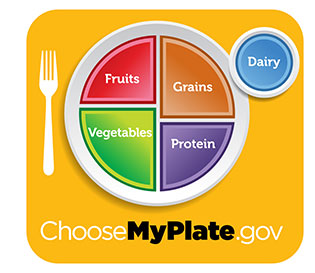Fact Sheet FS1057
ChooseMyPlate.gov Guidelines
Healthy Family Eating
Parents are busy people trying to make sure the family is eating a nutritious, balanced diet which can be a challenge in a fast food world. Here are some easy suggestions to make healthy eating a way of life for your family.
Orange: Grains. Grains are foods such as bread, oatmeal, rice, and pasta. At least half of the grain products your family eats should be whole grains. These are foods that have not been processed. Examples include whole wheat bread, brown rice, and whole oats/oatmeal. Whole grain products have more fiber and nutrients than white bread or those made with bleached white flour. Fiber helps keep the digestive system regular. Grains are also sources of carbohydrates, or “carbs” and provide quick energy for the body.
Green: Vegetables. There are five main categories of vegetables: dark green, like spinach; orange, like carrots; legumes (dried beans), like lentils; starchy, like sweet potatoes; and other vegetables, like onions. Eating a variety of vegetables of different colors can reduce the risk of heart disease, stroke, diabetes, and some cancers. Vegetables also contain important nutrients like vitamins A and C as well as fiber.
Red: Fruits. Examples of fruit are oranges, apples, bananas, strawberries, and melon. Fruits are important sources of vitamins and minerals that your family needs. Eat whole fruit which is rich in fiber rather than drinking fruit juices.
Oils and Fats. The two types of fat we worry about most are saturated and trans fats, because they contribute to heart disease. You should limit butter and foods such as cookies, pastries, French fries, high-fat cheeses, hamburgers, hot dogs, deli meats, chips, and high fat desserts. Eat these foods in moderation. Avoid foods that say “partially hydrogenated vegetable oil” on the label as they contain a lot of saturated and trans fats. Instead, consume unsaturated fats/oils like olive oil, corn oil, canola oil, soy oil, or soft margarines.
Blue: Milk Products & Calcium-Rich Foods. This group includes milk, cheeses, and yogurt. It is especially important that families get enough servings of this group because calcium builds bone strength. If children are under two, they should drink whole milk, and eat cheese and yogurt made from whole milk. For kids over the age of two, choose 1% low-fat or fat-free milk products. If family members are lactose intolerant, lactose-free products are available. Those who do not consume cow’s milk for various reasons can have calcium-containing soy or almond milk or tofu.
Purple: Proteins. This group includes meat (choose lean cuts of meat) fish, beans, eggs, and soy-based foods like tofu. Proteins help build muscle in our bodies.
How Much of Each Food Group Should Children Eat?
A child’s age, sex and activity level are all factors that determine how much to eat every day to stay healthy. Boys and girls even of the same age grow at different rates and thus may be different sizes and need more or less calories. You can go to www.choosemyplate.gov and enter specific information on your child to get an individual diet just for them.
Tips for Healthy Families
- Have meals together as often as possible. Eating together as a family will help your children learn healthy eating habits. Meal planning, food shopping, and preparation should be a team effort. Try a family breakfast if dinner is too hard to get everyone together. Buy healthy ready-to-eat foods from a store or restaurant when time is limited.
- Don’t skip breakfast. Studies show that kids learn better if they eat breakfast. Start the night before—get foods ready and set the table. Encourage family members to leave enough time to eat in the morning by offering them quick, easy foods they like, such as low-fat granola bars, fruit, and yogurt.
- Make healthy foods available at home. If you stock your home with nutritious foods, your family’s meals will be healthier. Limit sugary sodas and soft drinks. Try to have at least two or more fruits or vegetables with every meal. Keep a bowl of fruit on your kitchen table or counter for snacks. Canned and frozen vegetables are often less expensive and have a longer shelf-life. Serve lean meats (like chicken and turkey) and other good sources of protein (like eggs and fish). Choose whole-grain breads and cereals. For children over age two, choose 1% or fat free milk rather than whole or 2% milk.
- Keep portion sizes small and do not over-feed your family. Never force children to eat if they are not hungry and make sure they eat healthy foods BEFORE they eat sweets or snack foods. There’s no need to ban the chips and candy forever—just make these “once-in-a-while” foods. Help your family have healthy attitudes about food.
- Make sure water is the beverage of choice for adults and children so all family members stay hydrated throughout the day.
For more information, visit Rutgers Cooperative Extension Department of Family and Community Health Sciences and Get Moving - Get Healthy New Jersey
October 2020
Copyright © 2024 Rutgers, The State University of New Jersey. All rights reserved.
For more information: njaes.rutgers.edu.
Cooperating Agencies: Rutgers, The State University of New Jersey, U.S. Department of Agriculture, and Boards of County Commissioners. Rutgers Cooperative Extension, a unit of the Rutgers New Jersey Agricultural Experiment Station, is an equal opportunity program provider and employer.


